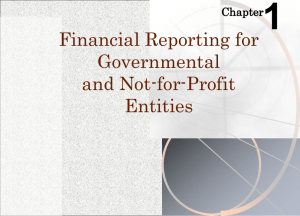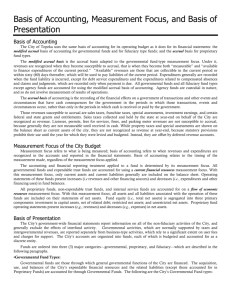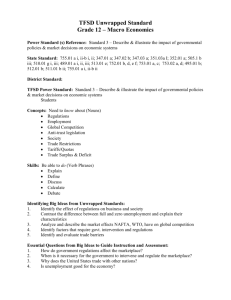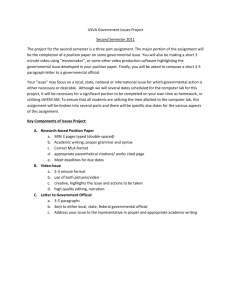How to Read Governmental Financial Statements, Part 1
advertisement
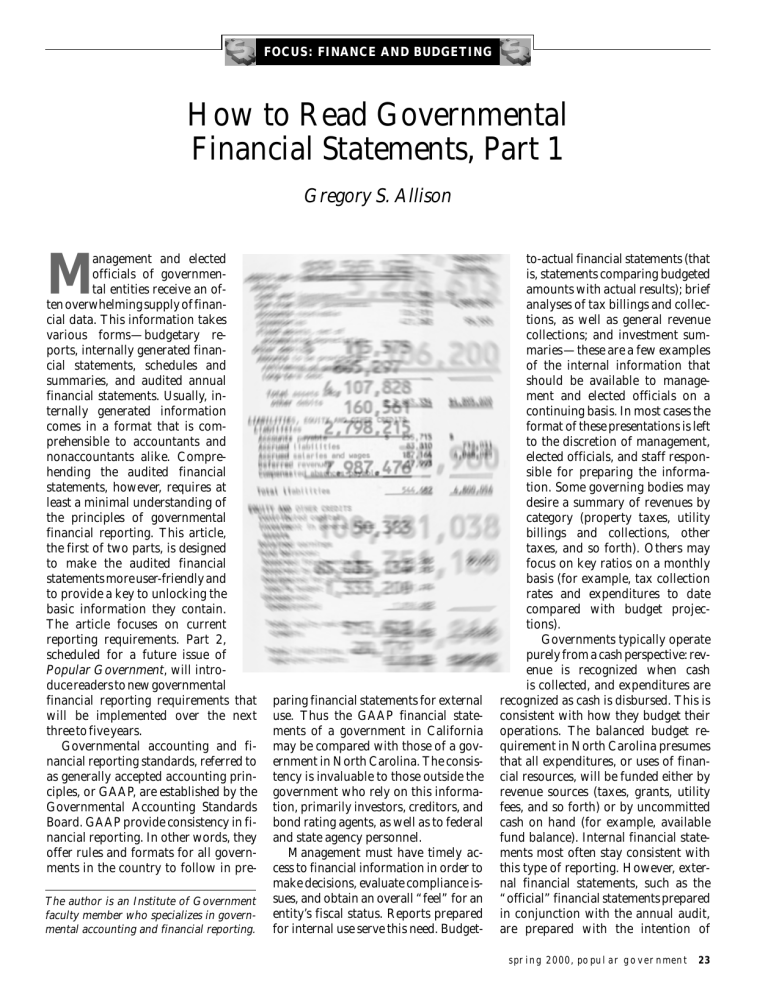
FOC U S: FI NANC E AN D BU DG ETI NG How to Read Governmental Financial Statements, Part 1 Gregory S. Allison anagement and elected officials of governmental entities receive an often overwhelming supply of financial data. This information takes various forms—budgetary reports, internally generated financial statements, schedules and summaries, and audited annual financial statements. Usually, internally generated information comes in a format that is comprehensible to accountants and nonaccountants alike. Comprehending the audited financial statements, however, requires at least a minimal understanding of the principles of governmental financial reporting. This article, the first of two parts, is designed to make the audited financial statements more user-friendly and to provide a key to unlocking the basic information they contain. The article focuses on current reporting requirements. Part 2, scheduled for a future issue of Popular Government, will introduce readers to new governmental financial reporting requirements that will be implemented over the next three to five years. Governmental accounting and financial reporting standards, referred to as generally accepted accounting principles, or GAAP, are established by the Governmental Accounting Standards Board. GAAP provide consistency in financial reporting. In other words, they offer rules and formats for all governments in the country to follow in pre- M The author is an Institute of Government faculty member who specializes in governmental accounting and financial reporting. paring financial statements for external use. Thus the GAAP financial statements of a government in California may be compared with those of a government in North Carolina. The consistency is invaluable to those outside the government who rely on this information, primarily investors, creditors, and bond rating agents, as well as to federal and state agency personnel. Management must have timely access to financial information in order to make decisions, evaluate compliance issues, and obtain an overall “feel” for an entity’s fiscal status. Reports prepared for internal use serve this need. Budget- to-actual financial statements (that is, statements comparing budgeted amounts with actual results); brief analyses of tax billings and collections, as well as general revenue collections; and investment summaries—these are a few examples of the internal information that should be available to management and elected officials on a continuing basis. In most cases the format of these presentations is left to the discretion of management, elected officials, and staff responsible for preparing the information. Some governing bodies may desire a summary of revenues by category (property taxes, utility billings and collections, other taxes, and so forth). Others may focus on key ratios on a monthly basis (for example, tax collection rates and expenditures to date compared with budget projections). Governments typically operate purely from a cash perspective: revenue is recognized when cash is collected, and expenditures are recognized as cash is disbursed. This is consistent with how they budget their operations. The balanced budget requirement in North Carolina presumes that all expenditures, or uses of financial resources, will be funded either by revenue sources (taxes, grants, utility fees, and so forth) or by uncommitted cash on hand (for example, available fund balance). Internal financial statements most often stay consistent with this type of reporting. However, external financial statements, such as the “official” financial statements prepared in conjunction with the annual audit, are prepared with the intention of spring 2000, popular government 23 “providing a single financial report tailored to meet the basic information needs of a broad range of potential users.”1 These audited financial statements are in a format that is useful for those with an understanding of governmental accounting—for example, accountants, investors, lenders, and rating agents—and they provide an excellent summary of the fiscal year’s financial events. Ironically the preparation of these GAAP financial statements is the specific responsibility of management, but they often are confusing and of little practical use to management and elected officials on a day-to-day basis. Nevertheless, management and elected officials can easily obtain useful information from these statements. Overview of GAAP Reporting Requirements GAAP require that state and local governmental entities use fund accounting, a concept unique to the government environment. Unlike agencies in the private sector, governmental entities provide a tremendous variety of services. Some services are “public purpose” in nature (for example, public safety, public works, and social services). Others are “business-like” (for example, public utilities). The public-purpose services are primarily financed by taxation (property taxes, sales taxes, income taxes, and so forth), whereas most business-like services are primarily financed by user fees (that is, payments by those using the services). In most cases the various revenue sources for the services each have restrictions on how they may be used. Fund accounting is an accounting and reporting vehicle that allows segregation of these services and their revenue sources. Fund accounting uses three basic categories of funds: governmental, proprietary, and fiduciary. Within each category, several fund types are available to account for all the government’s activities and services (see Table 1). To present the minimum information required by GAAP, governmental entities must prepare up to six basic financial statements and a comprehensive set of related “note disclosures” (footnotes that communicate essential information not disclosed in the body 24 popular government, spring 2000 Table 1. Fund Types General fund Accounts for general operations of government (e.g., legislative, administrative, public safety, sanitation, and recreation) Special revenue fund Accounts for legally restricted revenue sources, those that must be used for particular activities (e.g., E-911 taxes and community development block grants) Debt service fund Accounts for resources that governments are required to accumulate to pay debt service in future years Capital projects fund Accounts for major capital activities or construction that is being financed by governmental resources (e.g., taxes) or by bonds that will be repaid by governmental resources Enterprise fund Accounts for activities that are usually supported by user fees (e.g., water, wastewater, electricity, and natural gas services) Internal service fund Accounts for internal activities that provide service to other departments (e.g., government motor pools, in-house print shops, and warehousing for utility activities) Trust and agency funds Account for various activities for which government acts as fiduciary (e.g., pension plans, execution of trust and bequest agreements, and taxes collected on behalf of other governments) __________________________________________________________________________________________ of the financial statements themselves; see the sidebar, page 25). North Carolina statutes require that all local governmental entities prepare these GAAP financial statements for the end of each fiscal year and have them audited by an independent certified public accountant.2 These basic financial statements present aggregated information for each fund type. For example, a government may have three special revenue funds, such as a community development block grant fund, a capital reserve fund, and an E-911 fund. For the basic audited financial statements (often referred to as the combined financial statements), that government combines these three special revenue funds into one column and identifies that column as the special revenue funds. Some argue that this aggregation diminishes the usefulness of the financial information. Most users of the information, however, are assessing the government’s financial situation as a whole. They do not necessarily need all the supporting detail. In contrast, internal reporting almost always has a focus on the activities of individual funds, which is necessary from an internal decision-making perspective. The Combined Balance Sheet— All Funds The combined balance sheet reports the assets, the liabilities, and the equity for each of the government’s fund types (for a sample, see Exhibit 1, page 26). The balance sheet is actually a “snapshot” of the assets, the liabilities, and the equities—that is, the net worth—of the fund types as of the end of the fiscal year (June 30 for most North Carolina governments, such as municipalities and counties). “Assets” is simply defined as items owned by the government (cash, investments, receivables, fixed assets, and the like), and “liabilities” is defined as obligations of the government (for example, accounts payable, salaries payable, and bonds payable). “Equity” is the net worth of each of the fund types, which is simply the fund’s assets minus its liabilities. This balance sheet is a visual representation of the standard “accounting equation”: Assets = Liabilities + Equity Each fund type is reported in a separate column. Assets equal liabilities plus equity for each column. Unlike the operating statements, the balance sheet does not represent an accumulation of transactions across the year. Instead, it answers the following questions: • What does each fund type own as of June 30? • What does each fund type owe as of June 30? • What is each fund type’s net worth as of June 30? Management and elected officials make decisions at the individual-fund Note Disclosures I n addition to requiring the basic financial statements, GAAP require a comprehensive set of note disclosures. Because of their obvious limitations, the basic financial statements cannot provide details about every number reported. The note disclosures provide critical details about financial issues that are of importance to users of the financial statements. Some of the more significant types of disclosures are the following: • Significant accounting policies • Compliance issues • Deposit and investment detail • Fixed-asset information • Information on outstanding long-term debt • Pension plan information These categories of note disclosures are very broad, and a complete discussion of each one is beyond the scope of this article. However, together with the brief descriptions that follow, they provide a basic overview of the types of disclosures that are typically of most interest to management and elected officials. Significant accounting policies. This category encompasses various accounting and financial reporting policies of the government. Examples include a complete identification of the governmental entity and its fund structure, budget practices, calendar, and investment and fixedasset policies. Although much of this information is standard from government to government, the overall accounting and reporting policies are unique to each entity. Compliance issues. Governmental entities have extensive concerns with legal compliance related to the budget, bonds, investment policies, and more. GAAP require disclosure of any violations of these legal requirements. For example, if a government exceeds its budget appropriation in any department, it must disclose this violation of the budget ordinance. Likewise, if a government makes investments that violate its adopted investment policy, it must disclose that fact. Deposit and investment detail. This information is of paramount importance to readers of the financial statements. North Carolina statutes require investment of all idle public funds to maximize their earnings potential. State statutes also require insurance of all deposits and all investment securities, to limit the risk to which public level, not at the fund-type or total level. For example, if a government is assessing its ability to finance expansion of a water plant, either with cash on hand or through issuance of debt (such as bonds), it does not look at its cash position as a whole. Instead, it looks at the water fund and that fund’s cash position, asking, Is cash available in the fund to finance the project? The broad funds are exposed. (Depositories and investment dealers usually insure government deposits and investments by “collateralizing” them—that is, by setting aside collateral as insurance.) GAAP require disclosures about the types of deposits and investments held by the government at the end of the fiscal year, as well as the collateral for those deposits and investments. Fixed-asset information. In most cases, the fixed assets reported on the combined balance sheet represent the majority of the assets owned by the government. However, space limitations do not allow detail on the types of assets owned (land, buildings, equipment, and so forth), their original cost value, and, if applicable, the accumulated depreciation on the asset. The note disclosures provide this detail. GAAP also require a summary, by type of asset, of the additions to fixed assets that occurred during the fiscal year and the retirements (the assets taken out of use). Information on outstanding long-term debt. This is critical information to anyone assessing the government’s financial situation. Although all the government’s liabilities are reported on the combined balance sheet, it is impossible to provide detail on the types of indebtedness and the specifics for each liability. GAAP require disclosure of the outstanding debt issuances, the interest rate being paid, and the repayment terms. They also require inclusion of a schedule that shows the amounts of principal and interest due each year for five years, and in fiveyear increments thereafter, until maturity. The requirements for repayment of principal and payment of interest must be reported separately. Pension plan information. Pension plans are significant operations and represent significant costs for most governments. Many governments participate in the North Carolina Local Governmental Employees’ Retirement System; others sponsor their own plans. Also, some governments supplement the state’s plan or their own plan with a deferred compensation plan. If the government participates in the state plan, then it must make disclosures about the nature of the plan and the annual costs that it incurs to participate. If the government sponsors its own plan, then it must identify the assets and the liabilities of that plan, as well as the funding requirements, in the disclosures. perspective represented in the total columns of the balance sheet does not serve this kind of purpose. GAAP have specific rules for the types of assets and liabilities that may be reported for certain funds. Exploring all the theoretical reasons for these requirements is beyond the scope of this article. Suffice it to say that governmental funds (that is, general, special rev- enue, capital projects, and debt service) focus on financial assets and financial liabilities, whereas proprietary funds (that is, enterprise and internal service) focus on all assets and all liabilities. A financial asset is an asset that either is in cash form or will convert to cash in its natural course. Cash, investments, and receivables are the most common examples. A financial liability is a very spring 2000, popular government 25 Exhibit 1. This is an example of a combined balance sheet for a local school district, in this case the Craven County Board of Education. This governmental entity has a general fund, a capital projects fund, an enterprise fund, and several trust funds. Note the account group columns, which report the fixed assets and the long-term debt associated with the governmental funds. short-term liability, to be paid off soon, presumably with cash that is on hand or will be received in the near future. The most common examples are vendor accounts payable and accrued payroll. Governmental funds report only financial assets and liabilities. Nonfinancial assets, such as fixed assets (land, buildings, equipment, and so forth) and long-term liabilities (for example, bonds payable that will be paid off over many years) are not recorded in the 26 popular government, spring 2000 governmental fund columns themselves. Of course, governmental funds purchase such assets and incur such long-term liabilities. However, these items are included on the balance sheet in the columns for the general fixedasset account group and the general long-term debt account group, respectively. Thus a user can determine the types of fixed assets a governmental fund owns, or the types of liabilities a governmental fund will be repaying over the long term, by reviewing the information included in these columns. This GAAP reporting approach, in fact, is consistent with how governmental funds are budgeted and managed. The budget for one year is designed to provide the resources to deliver services for that year. Proprietary funds, on the other hand, are managed with a long-term perspective. They operate more like a private-sector business, in which the focus is on net income. Water rates, for example, are structured not only to provide resources for the current year’s operations but also to generate the necessary capital to maintain the systems in perpetuity. Therefore the GAAP balance sheet presentation for the proprietary funds reflects all their assets and liabilities—both financial and nonfinancial assets, and both current and long-term liabilities. Many of the account captions on the balance sheet are relatively selfexplanatory (for example, cash, investments, taxes receivable, accounts payable, and bonds payable). However, other account captions that may be of particular interest to management and elected officials merit additional description. Due from/to other funds. Often, funds within a government provide services for one another. For example, the general fund pays for the water provided to city hall by the water department, which is accounted for in the water fund (a proprietary fund type). Suppose the water fund has billed the general fund for the most recent month’s water usage, but the fiscal year ends before the bill is settled. The water fund reports a “due from other fund,” which is a receivable, and the general fund reports a “due to other fund,” which is a payable. This terminology is used in lieu of the usual “accounts payable/ accounts receivable” to reflect that the underlying transaction is between funds within the government, not between the government and outside parties (for example, customers and vendors). Interfund receivables/payables and advances to/from other funds. Occasionally one fund may lend money to another fund. For example, the general fund may borrow money from an electric fund to purchase a computer system. The transaction is reported as a loan between funds, using terminology that reflects the repayment terms.3 The current portion of the loan (for example, the amount to be repaid within the next year) is reported as an “interfund receivable” in the fund that is to be repaid, and as an “interfund payable” in the fund that is repaying the loan. The long-term portion of the loan is reported as an “advance to other fund” (a receivable account) in the fund that is to be repaid, and as an “advance from other fund” (a liability account) in the fund that is repaying the loan. Intergovernmental receivables/payables. State monies paid to local governments in North Carolina are a common example of an intergovernmental transaction, as are subsidies paid by municipalities to local housing authorities. If any of these receivables or payables are outstanding at the end of a fiscal year, they are captioned “intergovernmental” to reflect the underlying nature of the transaction. Compensated absences payable. As of the end of each fiscal year, the government has incurred a liability to its employees for earned vacation and similar types of compensation time. This kind of liability is reported in several sections of the balance sheet. The amount owed to general fund employees is most commonly reported in the general long-term debt account group. Likewise, the amount owed to employees in the proprietary operations is reported directly in those fund-type columns. These amounts do not represent liabilities that the government will pay out in total at one time. GAAP require a presentation of the full liability, but in practice the government pays the amounts to employees incrementally as they use their vacation or similar compensation time. Deferred revenue. In governmental funds, revenue is recognized as it is available (that is, as it is received in cash or becomes receivable in cash in a very short period).4 In proprietary funds, revenue is recognized as it is earned, regardless of when it is actually collected in cash. In governmental funds, such as the general fund, tax revenue is recognized not as it is billed but as it is collected. When property taxes have been billed but not paid as of the end of the fiscal year, and are not collected within sixty days after the end of the fiscal year, both GAAP and North Carolina statutes require that the amount of the tax receivable on the balance sheet be reported not as revenue but as “deferred revenue,” which is reported similar to a liability. Deferred revenue does not increase fund balance because it is not available for appropriation (that is, the cash it represents is not available). Another common example of the creation of deferred revenue is associated with grants. This situation might occur in either a governmental or a proprietary fund. Assume that a local government receives a federal grant. The grant is paid to the government in advance, but the government does not earn the right to keep it until certain criteria have been met (for example, the grant must be actually spent for its particular purpose to become revenue; until that time it is technically refundable to the grantor). Until the government meets the grant requirements, it must report the amount as deferred revenue. As the grant provisions are met, the deferred revenue is reclassified as revenue on the appropriate operating statement. Equity. As stated earlier, equity is the net worth of a fund. Governmental financial reporting uses different terminology for equity in the different fund types. Following is a summary of the various equity accounts. Fund balance. This term describes equity for the governmental fund types. Because the assets in a governmental fund are all financial ones and the liabilities are all current ones, fund balance actually represents the net financial resources potentially available in that fund. However, North Carolina state statutes include a formula that identifies how much of fund balance is actually available for appropriation. Governments may not appropriate more than “the sum of cash and investments minus the sum of liabilities, encumbrances, and deferred revenues arising from cash receipts.”5 (An “encumbrance” is an outstanding commitment of funds usually documented by a purchase order or a contract.) In addition to that statutory limitation, there are restrictions on portions of fund balance. “Reserved fund balance” reflects legal restrictions placed by independent third parties. Management or elected officials may not use reserved fund balance for any purpose other than that to which it is restricted. In North Carolina some common examples of reservations are the following: Reserved by state statute. Fund balance is a close approximation of spring 2000, popular government 27 resources that will eventually be available in a governmental fund. North Carolina statutes prohibit a government from considering receivables as resources that it may appropriate in its calculation of available fund balance. “Reserved by state statute” generally reflects the amount of fund balance that is attributable to receivables that the applicable governmental fund has recognized as revenue under GAAP but may not yet appropriate under North Carolina law. Reserved for encumbrances. Often there will be outstanding encumbrances (that is, outstanding purchase orders or contracts) at the end of the fiscal year. A reservation for encumbrances indicates that a portion of fund balance is dedicated to pay for the encumbered items once the goods or the services have been received, presumably early in the next fiscal year. Technically the vendor with whom the purchase was made is the independent third party who has a claim on these resources. Reserved for Powell Bill. Municipalities in North Carolina receive annual allotments of Powell Bill money from the state. Powell Bill money may be used only for specific street construction and maintenance projects. Usually, municipalities have unspent portions of the distribution in their fund balance at the end of each fiscal year. Although they may use it in future fiscal years, the state legally restricts how they may use it. Thus portions of unspent Powell Bill money as of the end of the fiscal year must be reported as reserved fund balance. Portions of fund balance that are not reserved are considered to be unreserved. This classification may be further categorized as “designated” or “undesignated.” The primary difference between a reservation and a designation is the role that the governing body plays in the latter’s determination. Elected officials may designate portions of available fund balance for any number of purposes—future capital needs, operating-budget resources for the following year, special projects, or purchases. A designation is internally cre28 popular government, spring 2000 ated, is not legally binding, and may be modified as the elected officials desire. Obviously, undesignated fund balance reflects the portion of fund balance that is not legally reserved or designated by the governing board for future use. Retained earnings. Equity in the proprietary funds is referred to as “retained earnings.” Unlike equity in the governmental funds, equity in the proprietary funds reflects the total assets minus the total liabilities of the fund. Therefore, retained earnings reflect not only financial assets (minus financial liabilities) of the fund but all other assets, such as fixed assets (minus long-term liabilities). Total retained earnings do not represent spendable resources. As in the private sector, they reflect total net worth of the fund, which includes assets that are not convertible to cash for spending. Contributed capital. Sometimes a proprietary fund receives capital contributions from outside third parties. For example, a developer may pay for the installation of water lines in a new subdivision. When the water lines are connected to the local government’s water system, they become the property of the government. The water fund has received an asset at no cost. Contributed capital simply represents the equity that a proprietary fund has built with outside contributions. The total net worth of a proprietary fund is retained earnings plus contributed capital. The Combined Operating Statement: Governmental Funds There are two main types of operating statements for governments, one for the governmental funds6 and another for the proprietary funds. (As discussed later, some governments may have a third type of operating statement, for their pension trust funds.) Because governmental funds focus on current financial resources, the operating statement of a governmental fund is similar to a checkbook register (for a sample, see Exhibit 2). The revenues and the other financing sources are like deposits; the expenditures and the other financing uses are like withdrawals. The net result of these “deposits” and “withdrawals” is an increase or a decrease in the checkbook balance (that is, the fund balance). Revenues and expenditures. Most of the account categories under these cap- tions are self-explanatory. Examples of common revenue resources are property taxes, licenses and permits, charges for services (that is, user fees), interest, and receipts from other governmental entities (that is, intergovernmental revenues, such as sales taxes, grants, and other types of state-shared monies). Expenditures are typically categorized by “character” and “function.” “Character” identifies the nature of an expenditure: current, intergovernmental, debt service, and capital outlay. “Current character” expenditures are typically identified by function. The most common types of functions are general government, public safety, public works, sanitation, and recreation. Governmental funds use the term “expenditure” as opposed to “expense.” An expenditure is an actual outflow of cash resources. Because the governmental funds’ operating statement focuses on the cash perspective, this term is more appropriate for it. In contrast, the term expense is used for the proprietary funds’ operating statement because it focuses on all transactions of the operation, regardless of their effect on cash. An expense is an outflow of cash resources or the recognition of noncash transactions such as depreciation of capital assets and writeoff of bad debts. Broadly stated, an expense is an allocation of all the costs of an operation. Other financing sources/uses. Following revenues and expenditures, there usually is another category of transactions, referred to as “other financing sources (uses).” These are resources or uses that do not meet the basic criteria of a revenue or an expenditure. This category is not for miscellaneous revenues and expenditures. In fact, only a few kinds of transactions may be reported in this category, as follows: Operating transfers in/out. Funds often transfer money to other funds. For example, a proprietary fund may routinely transfer money to the general fund. The receiving fund reports the transaction as an “operating transfer in,” the contributing fund as an “operating transfer out.” In contrast, revenues and expenditures reflect transactions with third parties. Given that operating transfers are internal in na- Exhibit 2. This excerpt from Forsyth County's combined governmental fund operating statement shows information about the county's general fund. ture, it is more appropriate to consider them other financing transactions. Proceeds of debt issuances. Obviously a common resource for governmental entities is the issuance of bonds or similar financing instruments. When such debt is issued by a governmental fund, receipt of the debt proceeds increases the financial resources of the fund. Given that the operating statement of the governmental funds is similar to a checkbook, the proceeds of the debt issuance must be reflected. Categorizing them as a revenue source is inappropriate; they are simply a resource that was borrowed. Thus they are reported as an other financing source. Payments to bond escrow agents. Governments often refinance existing debt to take advantage of better interest rates or more favorable debt-service requirements. This type of transaction is referred to as a “refunding.” The actual transaction is rather simple. The government issues refunding bonds, and it uses the proceeds to pay off the existing debt. However, just as homeowners often may not prepay mortgages without penalties, governments may not prematurely liquidate many bonds until the maturity date or a predetermined “callable” date. Yet there are legal ways to effectively eliminate the government’s liability and satisfy the terms of the outstanding bonds at the same time. When the proceeds of the refunding bonds are received, they are paid to an independent escrow agent. That agent pays off the old indebtedness. Once these funds are placed with the escrow agent, they are no longer accessible to the government, and the government’s liability for the old bonds has effectively been satisfied. In the year this transaction takes place, the proceeds of the refunding bonds are reported as an other financing source, and the subsequent payment to the escrow agent is reported as an other financing use. Sale of fixed assets. Occasionally, governments dispose of fixed assets purchased by the governmental funds. Any proceeds of the sale obviously add to the cash balance of the fund making the sale. These proceeds are reported as an other financing source. The net effect of revenues and other financing sources minus expenditures spring 2000, popular government 29 Exhibit 3. This is a portion of Wake County's budget-to-actual presentation, which shows the budgeted and actual revenues and expenditures of the general fund. and other financing uses of any governmental fund is an increase or a decrease in fund balance. Occasionally, other transactions may be reported on the governmental fund operating statement as direct adjustments to fund balance: Residual equity transfer in/out. Unlike an operating transfer, a residual equity transfer is an unusual and infrequent transfer of resources between funds. For example, the general fund may make a one-time contribution to a proprietary fund to help finance a capital project. The funds are not to be repaid, and the contribution is a one-time event. These transfers are reported as a “residual equity transfer in” to the receiving fund and as a “residual equity transfer out” of the contributing fund. Prior period adjustments. Occasionally, errors made in previous years need to be corrected. Also, adjustments may be necessary to reflect the implementation of a new accounting and financial reporting standard. Either of these 30 popular government, spring 2000 events would be reported as a direct adjustment to fund balance and identified as a “prior period adjustment.” Such adjustments do not necessarily reflect a problem. The ending fund balances for each of the governmental fund types should agree with the fund balances reported on the combined balance sheet. In summary, the balance sheet is a snapshot of the assets, the liabilities, and the equity (fund balance or retained earnings, as appropriate) at the end of the fiscal year (June 30 for North Carolina governments). The governmental fund’s operating statement reports the transactions throughout the year that either increase or decrease the applicable fund’s fund balance. The Combined Budget-to-Actual Statement: Governmental Funds GAAP require that the combined financial statements include a budget-toactual statement7 for governmental fund types that legally adopt an annual budget (for a sample, see Exhibit 3). The primary purpose of this statement is to demonstrate compliance with the budget. The statement has little practical use, for the fund-type columns still are aggregated. For example, if a government has more than one special revenue fund, the budget-to-actual presentation includes all of them in one column. For North Carolina governments, the formats of the combined governmental fund operating statement and the budget-to-actual statement are practically identical. The same account captions—revenues, expenditures, and other financing sources and uses— are used. GAAP simply limit this combined budget-to-actual statement to governmental funds that legally adopt an annual budget. Therefore, if multiyear (or project-length) budgets are adopted for special revenue or capital projects funds, they would not be included on the statement. The Combined Operating Statement: Proprietary Funds A governmental entity’s financial statements may include two types of operating statements if the entity has both governmental and proprietary funds. The operating statement for the proprietary funds8 is formatted differently from the operating statement for the governmental funds. The primary reason is that the statements are designed for different purposes. The governmental funds’ operating statement can be used like a checkbook register. Proprietary funds are reported from a perspective of total economic resources: all revenues earned, not just those that are available (as is the case with the governmental funds). Accordingly the expenses reflect all events that affect the equity of the fund—cash outflows for operations, purchase of capital assets, payment of debt service, and noncash transactions such as depreciation and write-off of bad debts. Operating revenues. This category on the proprietary funds’ operating statement identifies the revenues generated by the operation itself—for example, in the case of a water fund, fees earned for providing water. Also, revenues are recorded as they are earned, regardless of their availability (unlike the governmental funds’ operating statement). Otherwise, the account captions themselves are relatively selfexplanatory. Operating expenses. This category identifies the expenses generated by providing particular operations. In the preceding example of the water fund, all the direct costs of providing water service are considered operating expenses. Some common types of operating expenses are salaries and wages, employee benefits, materials, and supplies. Expenses incurred as part of the operation but not resulting in a cash outlay are included in the operating expense category. Two common examples are depreciation and bad debt expense. “Depreciation” is the allocation of the cost of an asset over its useful life. In the governmental funds, the full cost of acquiring a capital asset is recognized when the transaction occurs (for example, capital outlay expenditure). Therefore the financial reporting theory of depreciation does not apply. This is Exhibit 4. This is the first half of a proprietary fund operating statement— the revenues, the expenses, and the net income of Garner's enterprise fund (a type of proprietary fund). consistent with the focus of the governmental funds’ operating statement on transactions that affect cash. However, with the proprietary funds’ focus being much broader, the cost of a capital asset is allocated over its useful life, not simply expensed when it is purchased. Depreciation expense does not result in a cash outflow but systematically reduces the fund’s equity in an asset as it is being used. Bad debt expense occurs when service billings are not collected. Often, such accounts receivable are “written off” as a loss when it is determined that they will not be collected. Such losses are considered operating expenses. Operating income. The net of operating revenues and operating expenses is known as “operating income.” This amount simply identifies the income (or loss) generated by the operation itself. (For an excerpt of a statement showing operating revenues, operating expenses, and operating income, see Exhibit 4.) Nonoperating revenues and expenses. Many proprietary operations are subsidized by resources that are not generated by the operation itself. Common examples are taxes, grants, interest revenue, and intergovernmental revenue. In many cases these are substantial amounts. They are classified as “nonoperating” activities simply to indicate that they are not generated by the operation itself but are the result of external events (for example, taxation). Likewise, expenses are incurred that are not a direct result of the operation. The most common example is interest expense associated with a fund’s longterm debt. Transfers to/from other funds. Proprietary funds often receive operating transfers from other funds or provide transfers to other funds. For example, the electric fund may routinely transfer money to the general fund to keep property tax rates down (property taxes being the primary source of revenue for the general fund). When this occurs, the transactions are reported as gross amounts (that is, transfers in and transfers out are not combined into one sum) on the operating statement in a spring 2000, popular government 31 Exhibit 5. This is the second half of Garner's proprietary fund operating statement. This portion of the statement's column follows the revenue, expense, and net income portion shown in Exhibit 4. separate category immediately following the nonoperating category. Net income. Operating income minus nonoperating revenue and expenses, as well as transfers in and out of the fund, is captioned “net income.” This amount either increases the fund’s equity (that is, retained earnings), resulting in a net income, or decreases it, resulting in a net loss. (For an excerpt of a statement showing nonoperating revenues and expenses, and net income, see Exhibit 5.) The ending retained earnings should agree with the retained earnings reported on the combined balance sheet. Events such as residual equity transfers or prior period adjustments are reported as direct adjustments to the retained earnings balance. The Combined Statement of Cash Flows: Proprietary Funds As explained earlier, the governmental funds’ operating statement basically gauges the cash inflows and outflows of the governmental funds. In contrast, the proprietary funds’ operating statement includes cash and noncash transactions. Therefore the proprietary funds’ operating statement cannot be used effec32 popular government, spring 2000 tively to identify cash flows. GAAP require that governments with proprietary and nonexpendable trust funds include a statement of cash flows in their external financial statements (for an excerpt, see Exhibit 6).9 The statement of cash flows focuses on transactions that directly affect the fund’s cash balance. Governments have the option of focusing on cash alone or including cash equivalents. A “cash equivalent” is defined as a highly liquid, short-term investment that has an original maturity (maturity at the time of purchase) of no more than ninety days. Each of the cash flows is reported at gross amounts. Simply put, cash inflows are reported separately from cash outflows. For example, operating transfers in are reported separately from operating transfers out. This statement focuses on four categories of cash flows, as follows. The transactions identified within each category are relatively self-explanatory. Cash flows from operating activities. Any proprietary fund has cash inflows and outflows associated with the operation of the activity itself. The most common example of a cash inflow is collec- tions on utility billings. Examples of cash outflows are payments to vendors and employees. GAAP also require that miscellaneous cash inflows or outflows that do not fit the criteria of the other cash-flow categories be reported as operating activities. Cash flows from non-capitalfinancing activities. Often a proprietary fund will receive cash inflows or incur cash outflows that are indirectly related to the operation itself but not related to capital acquisitions. (This category is similar to nonoperating revenues and expenses, discussed earlier.) Common examples are tax revenues, grant revenues, and operating transfers from other funds. Examples of non-capitalfinancing cash outflows are operating transfers to other funds or grants made to other governmental entities. Cash flows from capital financing activities. Especially in proprietary funds, cash flows related to capital acquisitions can be very significant. Examples of cash inflows related to capital financing are debt proceeds associated with capital financing, grants restricted to acquisition of capital items, and transfers from other funds restricted for capital purposes. Also, cash generated by the sale of any fixed assets is reported as a cash flow from capital financing activity. Examples of cash outflows are purchase of capital items and debtservice payments when the debt is capital related. Cash flows from investing activities. The statement of cash flows segregates all activity associated with the fund’s investing activities. Sales or maturities of investments, as well as interest earned and collected on those investments, are reported as cash inflows in this category. Purchase of investments is the most common cash outflow associated with investing. The net result of all the identified cash inflows and outflows per proprietary fund type represents how cash10 changed from the beginning of the year to the end. The ending cash amount should agree with the cash amounts reported by fund type on the combined balance sheet. GAAP recognize that some transactions do not result in actual cash inflows or outflows but are not obvious on the proprietary funds’ operating statements. “Noncash” transactions that affect the assets and the liabilities of a fund, and would have been reported in the operating, non-capitalfinancing, or capital financing categories if cash had actually exchanged hands, must be disclosed in a separate noncash activities section of the statement of cash flows. Two of the most prevalent examples of this type of transaction are acquisition of a capital asset through a capital lease agreement (that is, acquisition of an asset and incurrence of a liability without any initial cash flow) and receipt of a capital asset by donation, such as water and sewer lines from a developer. The Statement of Changes in Net Assets: Pension Trust Funds Exhibit 6. This is an excerpt from fictional Carolina County's more extensive statement of cash flows. There is a column for each fund type; the information shown here is for the enterprise fund. Most local governmental entities participate in pension plans for their employees that are under the fiduciary care of another entity. The most common example of this in North Carolina is the Local Governmental Employees’ Retirement System. The state is the fiduciary of a pension plan that benefits participating local governmental employers and employees in North Carolina. However, some local governments either sponsor an additional plan for their employees only or provide a plan in lieu of participation in the statesponsored plan. The most common example is the Law Enforcement Officers’ Special Separation Allowance. In these cases the local government acts as the fiduciary of a pension plan, and GAAP require the inclusion of a separate operating statement for that plan (for a sample, see Exhibit 7) because the required format of the statement is so different from that of a proprietary fund. (The assets, the liabilities, and the equity of such a plan are included on the combined balance sheet.) The resources of a pension plan are categorized as “additions to net assets,” and the uses of those resources are categorized as “deductions from net assets.” Additions include contributions from employers, contributions from participating employees, and net investment income.11 Deductions include benefits (and refunds) paid to participants in the plan, as well as administrative spring 2000, popular government 33 mental accounting, management and elected officials can better fulfill their fiduciary duties. Notes Exhibit 7. This sample operating statement for Carolina County's pension trust fund is typical for a government required to report such information. expenses incurred in the operation of the plan. As with the operating statements of both the governmental and the proprietary funds, the net of these additions and deductions is the increase or the decrease in the pension plan’s equity for the year. Conclusion Financial statements for local governmental entities can be very complex. Those with at least limited knowledge of governmental accounting and financial reporting principles may have the 34 popular government, spring 2000 edge in interpreting the information, but any interested party certainly can glean useful information from these statements. External financial reporting is the specific responsibility of management. Management and elected officials must make every effort to understand the landscape of these financial statements. This article is designed not to teach the principles of governmental GAAP but to highlight for management and elected officials the fundamental information included in the combined financial statements. By understanding the basic logic of financial presentation, and the terminology unique to govern- 1. STEPHEN J. GAUTHIER, AN ELECTED OFFICIAL’S GUIDE TO FINANCIAL REPORTING at 8 (Chicago: Government Finance Officers Association, 1995). 2. N.C. GEN. STAT. § 159-34. Hereinafter the General Statutes will be cited as G.S. 3. Governmental financial statements sometimes report these interfund loan arrangements with the “due to/due from” terminology discussed earlier. Although this is technically not prohibited, the use of the different language is designed to identify clearly the underlying nature of the transaction. 4. GAAP define “availability” as revenue collected in cash as of the end of the fiscal year, or within a short period following the end of the fiscal year. The North Carolina Local Government Commission recommends that the availability period be no more than sixty days. In practice the short period is usually sixty to ninety days following the balance sheet date. 5. G.S. 159-13(b)(16). 6. If a government also has expendable trust funds, they will be included in a separate column on this statement. The technical title of a governmental fund operating statement is Combined Statement of Revenues, Expenditures and Changes in Fund Balances. 7. The technical title of this statement is Combined Statement of Revenues, Expenditures and Changes in Fund Balances— Budget and Actual. Most governments prepare additional statements and schedules that exhibit budgetary compliance for individual funds. For example, if a government prepares a comprehensive annual financial report, such information is included therein. 8. The technical title of the proprietary fund operating statement is Combined Statement of Revenues, Expenses and Changes in Retained Earnings. If a government also has a nonexpendable trust fund, it will be included in a separate column on this statement. 9. The technical title of the statement of cash flows is Combined Statement of Cash Flows. 10. Governments also may include cash equivalents. 11. Investment income is reported minus appreciation or depreciation of the fair value of investments, as well as administrative costs and costs associated with investment management (for example, an investment adviser’s fees).

